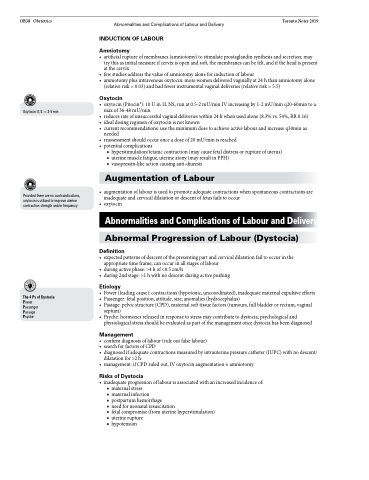Page 878 - TNFlipTest
P. 878
OB38 Obstetrics
Abnormalities and Complications of Labour and Delivery Toronto Notes 2019 INDUCTION OF LABOUR
Amniotomy
• artificialruptureofmembranes(amniotomy)tostimulateprostaglandinsynthesisandsecretion;may try this as initial measure if cervix is open and soft, the membranes can be felt, and if the head is present at the cervix
• fewstudiesaddressthevalueofamniotomyaloneforinductionoflabour
• amniotomyplusintravenousoxytocin:morewomendeliveredvaginallyat24hthanamniotomyalone
(relative risk = 0.03) and had fewer instrumental vaginal deliveries (relative risk = 5.5)
Oxytocin
• oxytocin(Pitocin®):10Uin1LNS,runat0.5-2mU/minIVincreasingby1-2mU/minq20-60mintoa max of 36-48 mU/min
• reducesrateofunsuccessfulvaginaldeliverieswithin24hwhenusedalone(8.3%vs.54%,RR0.16)
• idealdosingregimenofoxytocinisnotknown
• currentrecommendations:usetheminimumdosetoachieveactivelabourandincreaseq30minas
needed
• reassessmentshouldoccuronceadoseof20mU/minisreached
• potentialcomplications
■ hyperstimulation/tetanic contraction (may cause fetal distress or rupture of uterus) ■ uterine muscle fatigue, uterine atony (may result in PPH)
■ vasopressin-like action causing anti-diuresis
Augmentation of Labour
• augmentationoflabourisusedtopromoteadequatecontractionswhenspontaneouscontractionsare inadequate and cervical dilatation or descent of fetus fails to occur
• oxytocin
Abnormalities and Complications of Labour and Delivery
Abnormal Progression of Labour (Dystocia)
Definition
• expectedpatternsofdescentofthepresentingpartandcervicaldilatationfailtooccurinthe appropriate time frame; can occur in all stages of labour
• duringactivephase:>4hof<0.5cm/h
• during2ndstage:>1hwithnodescentduringactivepushing
Etiology
• Power(leadingcause):contractions(hypotonic,uncoordinated),inadequatematernalexpulsiveefforts • Passenger:fetalposition,attitude,size,anomalies(hydrocephalus)
• Passage:pelvicstructure(CPD),maternalsofttissuefactors(tumours,fullbladderorrectum,vaginal
septum)
• Psyche: hormones released in response to stress may contribute to dystocia; psychological and
physiological stress should be evaluated as part of the management once dystocia has been diagnosed
Management
• confirmdiagnosisoflabour(ruleoutfalselabour)
• searchforfactorsofCPD
• diagnosedifadequatecontractionsmeasuredbyintrauterinepressurecatheter(IUPC)withnodescent/
dilatation for >2 h
• management:ifCPDruledout,IVoxytocinaugmentation±amniotomy
Risks of Dystocia
• inadequateprogressionoflabourisassociatedwithanincreasedincidenceof: ■ maternal stress
■ maternal infection
■ postpartumhemorrhage
■ need for neonatal resuscitation
■ fetal compromise (from uterine hyperstimulation) ■ uterine rupture
■ hypotension
Oxytocin t1/2 = 3-5 min
Provided there are no contraindications, oxytocin is utilized to improve uterine contraction strength and/or frequency
The 4 Ps of Dystocia Power
Passenger
Passage
Psyche


